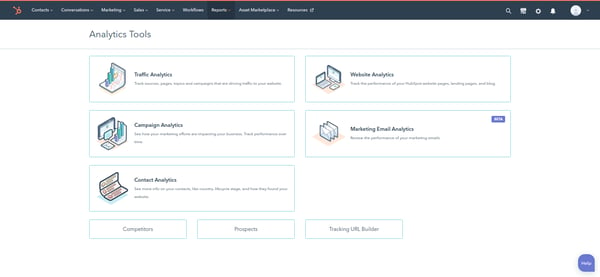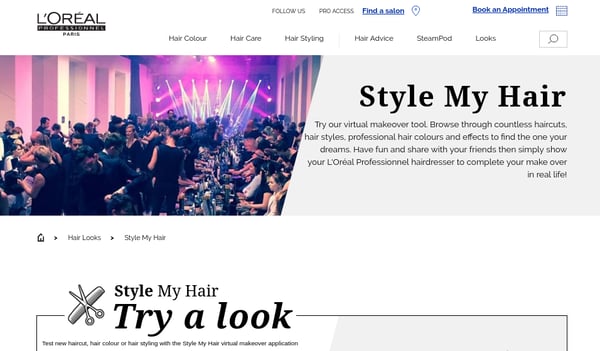All humans — including your customers — are emotional creatures.
That’s why it’s so important to make sure every interaction customers have with your company a memorable one — so memorable that they’ll want to recommend your business to a friend, family member, or colleague.
That connection between your business and customers is exactly what customer experience is all about — providing the support that your customers seek throughout all stages of the buyer’s journey.
You can think of the whole customer journey as a (very important) and complete transaction between your brand and customer, — what happens throughout that transaction and the way your customers feel define the customer experience.
For instance, you visit your local ice cream shop; the waitress welcomes you with your name and immediately asks if you’d like your regular treat, a chocolate sundae with extra chocolate chips, or if you’d prefer to look at a menu.
Wouldn’t this personalized and positive experience make you want to continue returning to that ice cream shop? Sometimes it hardly matters how the food tastes — the unique and delightful customer experience is what keeps you going back.
This doesn’t just apply to brick-and-mortar stores either. For example, when a prospect visits your website, why would they want to stick around to learn about your products or what your brand stands for if they don’t feel valued, understood, and heard? In this case, it won’t matter how beautiful your site isor how well you've optimized your site — what matters is CX.
Understanding Customer Experience (CX): How to See the World Through Your Customer’s Eyes
There are a number of ways a customer may interact with your business. For example, when they visit your website, engage with your social posts, click on your ads, purchase your product or service, or provide feedback. Customer experience includes all of these interactions and more.
A recent study by Oracle reveals maximizing customer satisfaction across the buyer journey increases total customer satisfaction by 20%, and drives revenue growth by up to 15%.
You need to see the world through customer-colored glasses. Understand their challenges and needs. They want to be heard and expect quick responses and speedy reactions from your team members.
Focus on client-centricity — put your customers first by searching for opportunities to create products and services that resolve the challenges of your customers. You can also identify your best customers with smart segmentation. There are a lot of benefits of customer segmentation including a better understanding of your customer’s behaviors, interests, and pain points.
Here are some great examples of how brands are enhancing their customer experience.
- When Tony started Zappos (now a billion-dollar brand), he rewarded his team for spending long hours over the phone to create a splendid customer experience.
- Apple added a human element to their customer interaction by installing experts at the Genius bar.
- FedEx ensured a better customer experience by answering every customer support call on the first ring.
Now that you know what CX is, let’s take a moment to review what it is not.
Customer experience is not user experience (UX).
Customer experience and user experience are separate strategies businesses deploy to help them grow.
User experience is a subset of customer experience. It revolves around your products. It’s all about how your customers interact with your products and what experience they have with them. User experience is a blend of design and architecture, usability, functionality, user-hierarchy, and understanding.
Whereas customer experience is a summary of the complete customer journey map. It starts when a visitor hears about you and exists throughout every interaction with Sales,Marketing, Customer Service, as well as with the product you sell.
Next, let’s review the ways in which CX impacts your conversions and why you may not be seeing the impact you’re hoping for on your bottom line just yet — and don’t worry, we’ll work through some ways to resolve those challenges too.
5 Reasons Why Your Customer Experience is Not Converting Prospects (Yet)
-
You don’t know your customers well.
The first reason for the low conversion rates is you don’t know who you are targeting. When you are not aware of your target audience, how would you guarantee their conversions?
How to fix it?
- Determine what your customers want, where their interests lie, what they like, and other common characteristics — everything that helps you reach your audience. (Make buyer personas to help you with this.)
- Run customer surveys and polls; they are the best way to collect customer information. The feedback you receive from there is filtered and gives you a quick view of your user requirements.
- Analyze your customers’ behavior with marketing analytics with HubSpot CRM.

- Segment your buyers based on their buying frequency, recency, and monetary metrics (RFM segmentation).
- Filter your best customers by separating them into categories with HubSpot’s Smart Lists, and send personalized emails to them.
2. Your products are not grabbing your user’s attention.
It’s an age-old saying that the first impression is the last impression. It’s very critical that the visitor’s first impression on viewing your products and your website as a whole is a pleasant one.
The buying decision of the vast majority of your website visitors is impacted by this first impression. If your products are visually appealing, the visitor is bound to take more interest and there is a good chance of conversion.
How to fix it?
When it comes to your eCommerce store, it’s important to keep in mind that your customers are buying products without necessarily ever having the ability to test them out and/or feel them first. So, you need to create an environment where they can make easy purchasing decisions that are virtual from start to finish.
There are a variety of ways through which you can enhance the customer experience and boost conversions.
- Use high-quality photographs and captivating videos to showcase your product and tell stories about your brand and product or service.
- Keep your products organized on your website and implement easy-to-use navigation.
- Leading fashion brands like L'oreal and Rayban allow users to try virtual makeover tools and provide a 360-degree view of their products. Such innovative leaps in presenting online products help these brands to stand out from others and attract huge audiences.

- Use augmented reality (AR) — this is a popular trend in the beauty and fashion industries because customers can try your products on virtually (e.g. a pair of sunglasses).
- Create an omnichannel experience for your online shoppers by augmenting product visualization.
- Be clear about your pricing strategy. According to Quicksprout, 56% of shoppers abandon their carts at checkout because of unexpected costs.
3. Your website isn’t ready for shoppers.
Did you know that 38% of people will stop engaging with a website if the content or layout is unattractive?
Also, 75% of consumers admit to making judgements on a company’s credibility based on the company’s website design.
If you are experiencing a solid amount of traffic but few conversions and a high bounce rate, your website design likely has issues.
How to fix it?
- If your website is suffering from low traffic, that may be because your audience isn’t getting what they are looking for. Make sure you are keeping everything on your website accessible for your users.
- Secondly, when a user visits your website, try to enhance the hero section (the header part) as beautiful, clean, and direct as possible. This section can contain your product, service, and offers too.
- Add clear call-to-actions (CTAs) throughout your webpage. Add a “view cart” option as well to heighten the chances of successful checkouts.
- Keep your website design conversion-focused. Put your menu bars (in the header and footer) organized. This will allow your users to navigate to find their goals quickly.
- Statista says there will be a total of 4.78 billion smartphone users in 2020. So if your website isn’t mobile-optimized, then you may lose conversions.
- Capitalize on your social media — use it to help you boost your top-performing content such as blog posts, customer reviews, and testimonials. Respond to feedback and answer customer questions through social media, too.
4. You’re unable to win your customer’s trust.
One reason for lower conversion rates is that you are incapable of winning your customer’s trust.
81% of online shoppers feel concerned when shopping on a website with which they are not familiar. Trust cannot be forced; let’s see how you can win your customers' trust naturally without a push.
How to fix it?
- Choose the right trust seal to improve security on your websites. Trust seals verify your website to be legal and lawful.
- Add customer reviews to your website to increase the chances of conversions and enhance your customer experience. According to BrightLocal, the average consumer reads 10 reviews before feeling able to trust a business.
- Be socially active, entertain, communicate, engage, educate, and run campaigns around your brand. Be real and stick to your niche and brand values.
- Engage your customers and earn their trust by establishing excellent communication practices.
- Add high-converting and relevant CTAs to your website above the fold. Use phrases and words like Learn More, Shop Now, Download, Sign-up, and Book Now.
5. You have not planned your customer onboarding.
Remember, there are two kinds of customer onboarding: on-site, and off-site. The fundamental difference between on-site and off-site onboarding is that, when a shopper lands on your website, it means they're looking for your products or services. In off-site, the customer has already been introduced to your products and services, before he/she needs them.
How to fix it?
- Offer a real-time product demo for your audience to help them explore your product and it’s features quickly. According to Wyzowl, 84% of people say that they’ve been convinced to buy a product or service by watching a brand’s video. Video demos impact purchasing decisions significantly and boost engagement as well.
- For a frictionless customer experience, it is crucial how you handle users who leave your website or intend to leave it.
- Use an immediate exit-intent pop-up.
- Set up an email marketing campaign and select time-slots to send interactive abandoned cart emails to lost users.
- Keep your cart visible to users.
- Use retargeting or remarketing ads to target users who have visited your website before.
- Be different — offer a dynamic free trial period for your products and services. Then, a user can extend the trial period and if they choose to. This provides a sense of flexibility and freedom for users.
Wrapping Up
Remember: Customers are humans, not your contact to close in the CRM.
Customer experience brings your customers closer to your brand. Humanize your brand and design, and analyze your customer journey map.
Light up your brand with a customer-centric approach and capture your shopper’s attention using the strategies mentioned above. For more information, check out the latest customer experience statistics & trends 2020 here.
Author Bio: Himanshu Rauthan is an entrepreneur and co-founder at MakeWebBetter, an eCommerce digital marketing agency, HubSpot Premier Integration and Gold Solutions Partner. He is a digital marketing and inbound expert, passionate about building and scaling eCommerce customer experiences.
HubSpot marketing teams reserves the right to use guest blog author’s likeness across our content as we see fit, including but not limited to HubSpot’s social media channels.
from Marketing https://ift.tt/3nWwbjn
via
No comments:
Post a Comment